Chora the capital of Amorgos

It was built in the 13th century by Venetian lords to avoid raids by Saracen pirates. The town of Amorgos with its traditional settlement, the whitewashed houses full of pots with basil and cloves, the numerous paved alleys, the masterfully made arches and the forty churches scattered in various places, is considered one of the most beautiful Cycladic villages, being undoubtedly the center of life of the island.
Wandering through the maze of narrow streets, from the North to the Vlycha and the Lower Neighbourhood, rarely bring you to the same places. In the North there are excellent elements of folk architecture, in the two-story houses with the very narrow “front”, the characteristic beds and the akrevatos (storage spaces under the bed, for grain).
The North is the oldest district of Chora, built on the roots of the castle. The oldest remains of habitation from the 3rd millennium were found here. You will also see fountains and wells. The historic building of the old school stands out in the district, behind the high school is Fotodotis Christos.
Platysteno or Mesi Odos, the paved central cobblestone that was built during the Venetian period, is the “backbone” of Chora. The neighborhood of Trullos with two-story houses and doors made of wood. The town of Amorgos has two squares, Kato, where the Holy Metropolis of Amorgos is located, and Apano Loza.
In the central square of Chora, Amorgian feasts are revived every year, such as Christ the Redeemer on August 6 and the Pastelio Festival. Churches of the Chora is the Byzantine church of the Holy Metropolis, dedicated to the Assumption of the Virgin Mary and St. John the Theologian, which was renovated in 1689.
Churches in Chora
In the lower neighborhood (western entrance of the Chora) is the Byzantine church of All Saints, which was renovated in 1644 with holy relics from the late 17th and 18th centuries! Also the church of Metamorfosis and Agios Stefanos (two-story), metochi of Panagia Chozoviotissa, the post-Byzantine churches of Agios Thomas, Agios Thalelaios and Stavros, the churches of Zoodochos Pigi and the Three Hierarchs, the small church of Agios Georgios at the entrance of the castle, of Agios Konstantinos below the Castle, the Byzantine church of Kera Leoussa, below the castle with the wonderful icon of the Virgin Mary, has been there for more than 15 centuries, being perhaps the oldest church in the village chronologically. It has a pronao as well as pre-Christian elements.
The people of Chora are good-natured and hospitable, willing to reward you for the honor you do them to visit the capital of Amorgos. Chora has two beautiful beaches, Agia Anna and Kambi beach. It has a developed tourist infrastructure of tourist shops, restaurants with several excellent taverns serving traditional dishes.
The Venetian Castle of Amorgos
The Venetian Castle of Amorgos is another attraction of the island and guardian of the Country. It is 65 meters high and was fortified by the brothers Jeremiah and Gyzi in 1207 during the period of the Venetian occupation, to avoid raids by Saracen pirates.
Today, parts of the wall with battlements are preserved. At the entrance is the small church of Agios Georgios with a panoramic view and is considered the trademark of the town. Around the castle spreads the traditional settlement with the numerous white Cycladic houses, mansions built and the numerous narrow alleys.

The windmills of Chora
The windmills that amphitheatrically enclose the settlement, on successive heights with an amazing view. Traditionally, the windmills were an important part of the island’s agricultural economy, used for grinding grain and producing flour.
These iconic structures were built to harness the strong winds that sweep across the island. Over time, many of the windmills have fallen into disuse and have been abandoned or transformed for other purposes.

